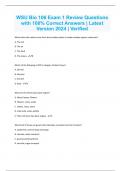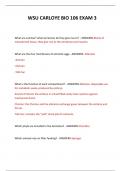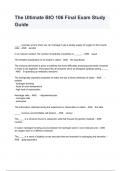Bio 106 - Study guides, Class notes & Summaries
Looking for the best study guides, study notes and summaries about Bio 106? On this page you'll find 313 study documents about Bio 106.
Page 4 out of 313 results
Sort by

-
Bio 106 WSU TOP Exam Guide Questions and CORRECT Answers
- Exam (elaborations) • 32 pages • 2024
- Available in package deal
-
- $9.49
- + learn more
What are the foundational principle of science? - All natural phenomena have a physical cause. (Not driven by supernatural causes. Ancient 7mes - thought supernatural forces drive natural processes) Science seeks to understand how nature works (Driving forces causing what we see around us. What will happen if we tweak a variable) Science also seeks to document everything that exists. (Organize it all by crea7ng categories based on shared traits. "Taxonomies") scientific hypothesis -...
WSU BIO 106 Bundled Exams Latest Versions with Certified Solutions

-
WSU BIO 106 Exam 1
- Exam (elaborations) • 8 pages • 2024
- Available in package deal
-
- $9.99
- + learn more
WSU BIO 106 Exam 1 The three basic plant organs, ________, are organized into_____________. - Leaves, Stems, Roots; A shoot system and a root system Nodes - The point at which leaves are attached Internodes - The stem segments between nodes Root - -An organ that anchors the plant into the ground -Absorbs minerals and water from the tip -Stores organic nutrients -Root hairs increase surface area and absorb most of the water and minerals Axillary Bud - A structure that has poten...
WSU BIO 106 Exam 1 Question and Answers (Latest Update 2024) Verified Answers
This is a comprehensive and detailed note on Chapter 12;Fresh Water, Oceans, and Coasts for Bio 106. *Essential!!
WSU CARLOYE BIO 106 EXAM 3 QUESTIONS AND ANSWERS 2024
The Ultimate BIO 106 Final Exam Study Guide Questions And Answers Graded A+!!!! The Ultimate BIO 106 Final Exam Study Guide Questions And Answers Graded A+!!!!

-
WSU Bio 106 Exam 1 Review Questions with 100% Correct Answers | Latest Version 2024 | Verified
- Exam (elaborations) • 15 pages • 2024
- Available in package deal
-
- $12.49
- + learn more
Where does the carbon come from that enables plants to make complex organic molecules? A. The soil B. The air C. The food D. The leaves - B Which of the following is NOT a category of plant tissue? A. Dermal B. Vascular C. Ground D. Root - D What are the three basic plant organs? A. Wood, leaves, flowers B. Flowers, roots, seeds C. Leaves, roots, stems D. Internode, node, petiole E. They only have two basic organs - C

-
WSU CARLOYE BIO 106 EXAM 3 QUESTIONS WITH CORRECT ANSWERS
- Exam (elaborations) • 9 pages • 2023
-
- $7.99
- 1x sold
- + learn more
Label the parts of the digestive system. CORRECT ANSWER Describe each step of the digestive process, where it occurs, and how it contributes to the process of digesting food and extracting nutrients. CORRECT ANSWER Chemical digestion by gastric juice is caused by the churning action of the stomach. Muscle contractions and relaxations mix the stomach every 20 seconds. This and enzymatic activity creates chyme. Both ends of the stomach are usually sphinctered. Why are "essential amino acid...

-
WSU BIO 106 LBL Questions with 100% Correct Answers | Latest Version 2024 | Verified
- Exam (elaborations) • 12 pages • 2024
- Available in package deal
-
- $11.49
- + learn more
Which of the following is NOT a defining trait of an animal? Eukaryote Multicellular Lack cell walls Feed by absorption Heterotrophic - Feed by absorption what the difference is between breeding and genetic engineering? - Genetic engineering allows the transfer of DNA material among completely different species, which is in most cases not possible for classical breeding Classical breeding often requires long time periods before a successful plant line has been established, genetic engi...

$6.50 for your textbook summary multiplied by 100 fellow students... Do the math: that's a lot of money! Don't be a thief of your own wallet and start uploading yours now. Discover all about earning on Stuvia







